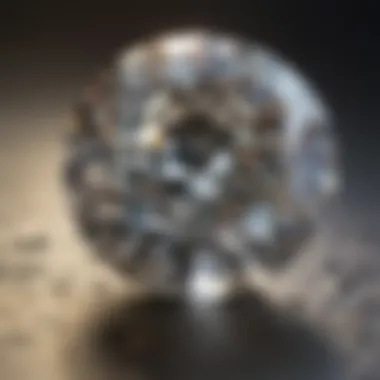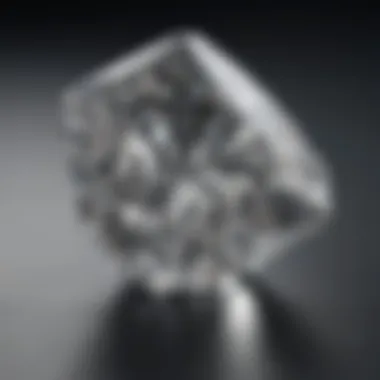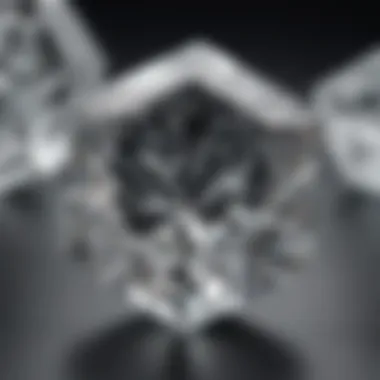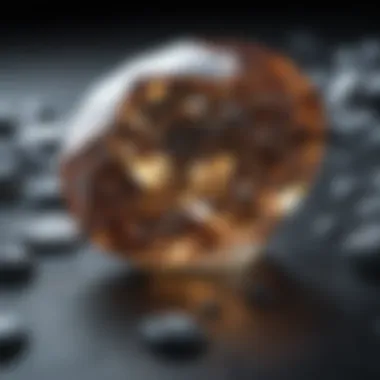Exploring Gemstones That Resemble Diamonds


Intro
The allure of gemstones that imitate diamonds extends beyond mere visual appeal. These stones carry unique histories, fascinating compositions, and variable market values. For collectors and enthusiasts, understanding these attributes is crucial. In this article, we will explore several notable stones that mimic diamonds, examining their characteristics, geological significance, and how they fit into the world of gemology.
Rock and Fossil Identification
Identifying rocks and fossils that resemble diamonds begins with understanding their types and unique features.
Types of Stones That Resemble Diamonds
Some common stones that mimic diamonds include Moissanite, White Sapphire, and Cubic Zirconia. Each of these has distinct properties:
- Moissanite: Known for its brilliance and fire, moissanite is a naturally occurring mineral that is synthetically produced today. It has a higher refractive index than diamond, making it exceptionally sparkly.
- White Sapphire: Sapphires can be found in a range of colors, but white sapphires present a colorless and clear aesthetic that is quite similar to that of diamonds, though they lack the same brilliance.
- Cubic Zirconia: Often used as a diamond substitute, cubic zirconia is entirely synthetic. Its clarity mimics the look of diamonds at a much lower cost.
Characteristics to Look For
To identify these stones, collectors should look for the following characteristics:
- Hardness: Diamonds score a 10 on the Mohs scale, while moissanite scores 9.25. White sapphires score 9, and cubic zirconia scores an 8-8.5.
- Refractive Index: Measure the light bending capability. Diamonds typically exhibit a high level of brilliance and fire.
- Specific Gravity: Different stones weigh differently despite similar sizes. This can help in identification.
Tools for Identification
Collectors can utilize various tools for proper identification:
- Loupe: A 10x jeweler's loupe will help detect inclusions and flaws in the stones.
- Gem Refractometer: Useful for measuring refractive index and determining the specific stone.
- Mohs Hardness Kit: A simple yet effective way to test the hardness of an unidentified stone.
Collecting Tips and Techniques
Successful collecting often hinges on good techniques.
Best Practices for Collecting
- Research Locations: Understand geographic areas where these stones are found naturally or abundantly in the market.
- Join Communities: Engage with local rock and mineral societies which often hold swaps and events.
Locating Prime Collecting Sites
Search for gem shows, mineral markets, or nature spots where these stones are known to occur. Online platforms like Reddit can be helpful to locate local hunting sites.
How to Safely Extract Specimens
Always use the right tools, like hammers, chisels, and gloves. Avoid damaging the environment by following local regulations for digging and extracting specimens.
Preservation and Display
Once collected, stones must be cared for properly to maintain their appeal.
Techniques for Preserving Rocks and Fossils
Keep them clean and away from harsh chemicals. Use a soft brush to remove dust and dirt.
Proper Storage Methods
Store stones in a soft pouch or a dedicated display case to prevent scratching.
Creative Display Ideas
Arranging stones in a shadow box or a glass cabinet allows for both security and visibility, making them visually appealing.
Geological Insights
Understanding the broader geological context enriches appreciation for these stones.
Geological Formations and Processes
Many of the stones that imitate diamonds form under similar high-pressure, high-temperature conditions as diamonds. Understanding where and how these processes occur can deepen one’s knowledge of gem science.
Historical Significance of Rocks and Fossils
Many of these stones have historical significance tied to discoveries of the earth's formation and the development of gemstone markets.
Notable Discoveries in the Field
Significant finds and research into these gemstones have transformed perceptions of value and desirability among collectors and jewelers.
"The true beauty of a gemstone is not just in its appearance, but in the story it carries within its structure."
As this exploration unfolds, the reader will gain not just information to identify and collect, but also an appreciation for the science underlying these magnificent stones.
Intro to Diamond-Like Stones
The fascination with gemstones that resemble diamonds goes beyond mere aesthetic appeal. Many collectors and enthusiasts are drawn to these stones due to their unique characteristics and the stories they tell. Understanding diamond-like stones is crucial in gemology, as it offers insights into how these alternatives can be both beautiful and valuable.


Definition and Characteristics
Diamond-like stones are gemstones that share similar visual qualities with diamonds but differ in terms of composition and origin. They may mimic the brilliance, clarity, and color of real diamonds. Common examples include cubic zirconia, moissanite, and white sapphire.
Characteristics to consider:
- Hardness: Many diamond substitutes are not as hard as diamonds, but some, like moissanite, approach diamond's hardness on the Mohs scale.
- Brilliance and Fire: Different stones emit light differently, affecting their sparkle. For instance, moissanite has a higher refractive index compared to diamonds.
- Color: Some mimic stones are available in various colors, while diamonds can range from colorless to shades of yellow or brown.
It is important to recognize these characteristics, as they can impact both the aesthetic value and market worth of the stones.
Importance in Gemology
In the realm of gemology, diamond-like stones hold significant importance for several reasons. These gems provide an alternative for individuals who may find natural diamonds too costly or ethically challenging. Additionally, studying these stones contributes to the broader understanding of gemstones, their properties, and their market dynamics.
The diversity of diamond substitutes is vast, and they serve various purposes in different markets. For collectors, knowing how to identify these stones and understanding their market value is essential.
"The study of diamond-like stones enriches gemology by illustrating the complexity and variety in the world of gemstones."
Overall, exploring these alternatives is not just about aesthetics; it opens a conversation about value, sustainability, and the choices available in the gemstone market.
Popular Diamond Substitutes
The relevance of popular diamond substitutes is significant in the context of this article. These stones present an attractive alternative to diamonds, made crucial by their availability, cost-effectiveness, and, in some cases, ethical advantages. Understanding these substitutes enables collectors and enthusiasts to make informed decisions when selecting gemstones that meet their aesthetic and financial expectations. Moreover, clarity regarding these options helps in examining the balance between value and appearance in the gemological market.
Cubic Zirconia
Properties
Cubic Zirconia (CZ) has quickly gained recognition as a diamond substitute due to its exceptional qualities. CZ is a synthetic gemstone, known for its brilliant luster and high refractive index, which gives it similar optical properties to diamonds. One of the notable characteristics of CZ is its effectiveness in replicating the sparkle of diamonds at a fraction of the cost. This affordability is a significant aspect for many buyers, making it a popular choice among jewelry enthusiasts. However, it is essential to note that CZ is less durable than diamond, which could limit its appeal for high-wear jewelry items.
Uses in Jewelry
Cubic Zirconia is widely used in various types of jewelry, including rings, earrings, and necklaces. Its versatility stems from its ability to be manufactured in different colors and cuts, allowing for extensive creativity in designs. The ease of mass production and low cost further enhance its appeal among jewelers and consumers alike. However, the perception of being "fake" can be a drawback for some collectors, impacting its desirability in certain contexts.
Market Value
The market value of Cubic Zirconia remains consistently low compared to diamonds and other gemstones. Its affordability makes it an accessible choice for consumers who desire the look of diamonds without the heavy financial burden. While this attribute is advantageous for casual buyers, it does mean CZ lacks the inherent value and investment potential associated with natural stones. It is important to keep this in mind when considering the long-term outcomes of purchasing cubic zirconia jewelry.
Moissanite
Chemical Composition
Moissanite is a naturally occurring silicon carbide that also serves as an impressive diamond alternative. Its unique chemical composition contributes to its remarkable hardness and brilliance. Moissanite is nearly as hard as diamond, which grants it durability and suitability for everyday wear. This makes it particularly appealing for rings that are worn daily, such as engagement rings. However, its distinct shine and optical characteristics can differentiate it from diamonds, which may be viewed as a disadvantage for some purists.
Visual Comparison to Diamonds
When comparing moissanite to diamonds, it becomes clear that moissanite exhibits a different type of brilliance. Moissanite demonstrates a higher dispersion of light, resulting in greater fire and rainbow-like flashes. This striking visual quality appeals to many consumers, yet it can also make moissanite look less like diamond, which is a factor to consider for those wanting a closer mimic of diamond's appearance.
Durability
Moissanite’s durability ranks high, as its hardness allows it to withstand daily wear and tear. This toughness, combined with its stunning visual properties, makes it an attractive alternative to diamonds. However, prospective buyers should still consider the potential for scratches and chips over time, particularly in rings that receive heavy use.
White Sapphire
Rarity
White Sapphire is a rare and natural gemstone, and its scarcity adds to its allure compared to more common substitutes. While white sapphires are still more readily available than diamonds, their unique qualities and less pronounced market presence make them desirable for collectors who appreciate their rarity. The supply of quality white sapphires can vary, affecting their market appeal and value over time.
Clarity and Cut
The clarity and cut of white sapphires play critical roles in determining their beauty and value. Well-cut sapphires can achieve quite a brilliant sparkle, although they typically do not match the brilliance of diamonds or cubic zirconia. This can be seen as a negative aspect for some, but others appreciate the understated elegance of white sapphires. High-quality cuts can enhance their clarity, leading to gemstone options that appeal to a discerning audience.
Historical Context
Historically, white sapphires were used in jewelry before the introduction of diamonds to the market. Understanding this context adds depth to their appreciation, as their elegance and value have been recognized for centuries. While their prominence has fluctuated, white sapphires remain an appealing choice for those who respect their history and significance in jewelry making.
Natural Stones That Resemble Diamonds
The exploration of natural stones that resemble diamonds is significant in understanding the broader context of gemology. These stones can provide alternatives for individuals who admire the aesthetic qualities of diamonds but seek budget-friendly or ethical options. Natural stones like topaz, rock crystal, and spinel possess characteristics that can imitate the visual appeal of diamonds, making them valuable in both jewelry and collection contexts. It is essential for enthusiasts to recognize these stones not only for their external beauty but also for their unique properties and historical significance.
Topaz
Color Variations
Topaz presents an extensive palette of color variations, ranging from the classic yellow to blue, pink, and even colorless options. This diversity is particularly attractive for collectors and jewelry makers as it allows for personalized expression. The color differences stem from various trace elements within the crystal structure. For instance, iron contributes to the golden hues, while chromium can create the striking pinks. The adaptability of color choices is a beneficial aspect that enhances its popularity as a diamond mimic in this article. Collectors appreciate topaz for its use in unique designs, but the market can be saturated with imitations, creating challenges in distinguishing authentic pieces.
Physical Properties
The physical properties of topaz include its hardness rating of 8 on the Mohs scale, making it a durable option for jewelry. This durability allows it to withstand daily wear, a crucial factor for those selecting stones for pieces that will be frequently worn. Moreover, topaz exhibits excellent clarity and brilliance, closely mirroring the traits of diamonds. These characteristics contribute positively to the overall topic as they make topaz a popular and resilient choice for imitation jewelry. However, one must be cautious, as the presence of treatment methods can impact the stone's authenticity and long-term stability.
Cultural Significance


Topaz holds historical value in many cultures, often associated with protection and strength. Ancient Egyptians believed it was a stone of the sun, while in other traditions, it was linked to wisdom and abundance. These aspects can amplify a collector's interest, as owning a gemstone with rich cultural heritage adds depth to any collection. From a market perspective, these narratives can enhance the value of topaz pieces, making them more desirable. However, its accessibility can also lead to lower rarity, which is a consideration when evaluating the stone's worth in the broader gem market.
Rock Crystal
Transparency
Rock crystal is valued for its remarkable transparency, often surpassing other natural stones. This property contributes to its appeal as a diamond substitute. The unclouded clarity captures light effectively, creating a sparkling effect reminiscent of diamonds. This transparency makes rock crystal an excellent choice for settings requiring brilliance, such as earrings and pendants. However, not all rock crystal is free from inclusions, which can affect its overall beauty and value, posing a challenge for collectors and buyers.
Historical Use in Art
Historically, rock crystal has been utilized in various civilizations, often carved into decorative items or religious artifacts. Its ability to be polished to a high luster made it a favorite among artisans. This historical usage provides a rich background to the stone, elevating its importance for today’s collectors. Learning about its historical context may also spark interest in the origins of current pieces. However, there can be a drawback, as the increased demand for historical items can inflate prices significantly.
Value Assessment
Value assessment for rock crystal can be complex as it varies enormously based on clarity, size, and craftsmanship. Transparent, larger pieces can command high prices, resembling diamonds closely in value perception. Collectors should evaluate these factors carefully when investing in rock crystal. However, the abundance of this material in nature means it may not retain its value in the same way as rarer gemstones. Understanding these dynamics can help collectors make informed decisions in their purchasing journey.
Spinel
Distinctive Features
Spinel is often overlooked as a diamond alternative, but it showcases distinctive features that stand out. Available in various colors, it can mimic diamonds, especially in its colorless form. Spinel is also known for its brilliance and has a lesser risk of appearing dull compared to other diamond simulants. For collectors, this distinctive quality can be attractive as it offers uniqueness without straying too far from traditional diamond aesthetics. However, misidentification with low-quality spinel can detract from its value proposition.
Origin and Sources
Spinel is sourced from various regions worldwide, including Myanmar and Sri Lanka. Its origins directly impact its value and appeal. Higher-quality stones from historically significant locations often yield better prices in the market. Collectors looking for investment quality should prioritize quality sources, which adds a layer of intrigue to their acquisition. However, the proliferation of synthetic spinel claims can complicate authenticity checks, raising caution for buyers.
Gemological Characteristics
The gemological characteristics of spinel further enhance its appeal as a diamond substitute. It has an impressive hardness of 7.5 to 8 on the Mohs scale and exhibits strong brilliance. This durability, paired with its vibrant colors, makes it a practical choice for jewelry. Spinel often offers collectors an affordable option that can withstand everyday wear without sacrificing aesthetic charm. However, potential buyers should be mindful of ongoing treatment processes that can impact its market value.
Synthetic Stones in the Market
The exploration of synthetic stones holds significant relevance in any discussion regarding diamonds and their alternatives. Synthetic stones, particularly lab-created diamonds and synthetic sapphires, offer numerous advantages for enthusiasts and collectors. These stones can provide an accessible entry point into the world of gemstones, allowing individuals to appreciate their beauty and durability without facing the prohibitive costs associated with natural diamonds. Moreover, advancements in technology have made producing synthetic stones both efficient and sustainable, thus appealing to modern ethical considerations.
Lab-Created Diamonds
Production Methods
Lab-created diamonds are produced through controlled processes, mainly High Pressure High Temperature (HPHT) and Chemical Vapor Deposition (CVD). These methods simulate the natural conditions under which diamonds form. This scientific approach ensures that the resulting stones possess similar physical and chemical properties to natural diamonds, including brilliance and hardness. The HPHT method, for example, introduces carbon into a pressurized chamber, creating diamonds within weeks rather than millions of years. The unique feature here is the ability to produce flawless stones, a characteristic that often makes them a more desirable choice for jewelry.
Cost Comparison
One of the prominent aspects of cost comparison between synthetic and natural diamonds is the significant price difference. Lab-created diamonds can typically retail for 20-40% less than their natural counterparts, depending on size and quality. This affordability allows collectors to invest in larger stones with similar beauty without straining their budgets. The unique feature of cost is that it encourages more people to consider quality over authenticity in certain situations, allowing wider appreciation for diamond-like stones.
Ethical Considerations
The ethical aspects surrounding synthetic stones present a compelling reason for their increased popularity. Lab-created diamonds do not contribute to conflict mining issues often associated with natural diamonds. Their production methods are environmentally friendlier, reducing the ecological footprint that comes with traditional mining. Consumers can enjoy the allure of a diamond—all while aligning their purchases with their values. This consideration speaks directly to the growing trend of ethical consumerism, making synthetic stones particularly appealing.
Synthetic Sapphire
Manufacturing Techniques
Synthetic sapphires are crafted using processes such as Verneuil, Czochralski pulling, or hydrothermal growth. Each technique yields high-quality stones that can rival natural sapphires in clarity and color. These methods enable the creation of sapphires in a variety of hues and sizes, catering to the diverse preferences of consumers. The key characteristic here is the ability to produce uniform stones without the flaws typically found in their natural counterparts. This consistency has made synthetic sapphires a favored choice in the luxury market.
Market Trends
The market for synthetic gemstones has seen notable trends, particularly a growing acceptance among traditional jewelers and consumers. As awareness increases regarding the benefits of synthetic stones, more individuals are opting for these alternatives. A distinct feature of this trend is the shift towards customization, where buyers seek unique creations without the high costs of natural stones. Observing these trends enables collectors to stay informed about pricing and availability, ensuring they make well-informed decisions.
Quality Standards
The quality standards for synthetic sapphires often mirror those for natural stones, focusing on aspects like color saturation, clarity, and cut. Certification bodies assess these stones similarly to their natural counterparts, ensuring buyers receive high-quality items. The significant benefit of these standards is the controlled parameters under which synthetic sapphires are produced. As such, buyers can expect a level of quality assurance that reduces uncertainty, enhancing consumer confidence when purchasing.
"Synthetic stones provide an intersection of beauty and ethics, allowing consumers to align style with values."
By understanding these facets of synthetic stones, collectors can not only appreciate their aesthetic value but also their role in a shifting marketplace. As technology continues to evolve, the landscape shaped by synthetic stones will likely expand, further enriching the options available to gemstone enthusiasts.
Evaluating Diamond-Like Stones
Evaluating diamond-like stones is pivotal in understanding their true value and potential for various applications. For collectors and enthusiasts, knowing how to assess these stones can enhance their appreciation and investment choices. Key aspects to consider include clarity, cut, carat weight, testing, and certification. Each element plays a vital role in determining the quality and desirability of these gemstones.
Factors Affecting Value
Clarity
Clarity refers to the presence of inclusions and blemishes in a gemstone. In diamond-like stones, a high clarity rating indicates fewer imperfections, translating into greater visual appeal and higher market value. Persons often choose clarity as a crucial criterion because it distinctly impacts the overall brilliance of the stone.
Strengths of clarity include its direct correlation to beauty and its essential role in appraisals. A unique feature is that clarity grades can vary significantly among different types of gemstones. However, a downside is that determining clarity can be subjective and may require expert evaluation.
Cut
The cut of a gemstone pertains to how well it has been shaped and faceted. A well-cut diamond-like stone will reflect light beautifully and showcase its innate qualities. The cut's importance lies in its ability to enhance a stone’s luster and brilliance. Investing in quality cut stones typically yields a more striking piece of jewelry or collection item.


One key characteristic of cut is that it combines angles and proportions, allowing for the best possible light return. A notable disadvantage is that poorly cut stones can look dull despite having high clarity. Thus, the cut serves as a significant benchmark for quality in diamond-like stones.
Carat Weight
Carat weight measures the size of the gemstone. Larger stones often command higher prices, both for their rarity and visibility. Carat weight matters because it is a straightforward metric that collectors and jewelers can quantify easily. The appeal of larger gemstones makes carat weight highly relevant for investment purposes.
However, a unique aspect of carat weight is that it does not automatically equate to value. Two stones with the same carat weight can differ significantly in price depending on their clarity, cut, and other attributes. Hence, while carat weight is a useful measure, relying solely on it may lead to oversights in assessing a stone's overall quality.
Testing and Certification
Certification Bodies
Certification bodies are organizations that evaluate and assess the quality of gemstones. Their role is crucial because they provide a standardized report that details the stone’s specifications, including clarity, cut, and carat weight. The credibility of certification bodies lends significant value to diamond-like stones.
A key characteristic here is that certified stones typically fetch higher prices due to the assurance they offer buyers. However, finding a reputable certification body is essential, as not all organizations adhere to the same standards, leading to variations in reliability.
Testing Methods
Testing methods are techniques employed to identify gemstone properties accurately. Various methods, including magnification, weight measurement, and spectral analysis, help in assessing a stone’s characteristics. Effective testing is fundamental to determine if a stone genuinely mimics diamonds.
One strong point of testing methods is their ability to reveal characteristics that are not immediately visible to the naked eye. Yet, the drawback lies in the potential costs and time associated with thorough testing, which may deter some individuals from pursuing certification.
Importance of Authenticity
The authenticity of a gemstone pertains to its verification as a genuine diamond simulant. This is especially crucial for buyers who seek value and longevity in their investment. Authenticity guarantees that the stone has been correctly assessed by professionals.
A major reason for focusing on authenticity is that it builds trust in the market. When collectors know their stones are legitimate, they can make informed buying decisions. However, the downside of authenticity can be the complexity of verification processes, which may discourage casual buyers from accessing detailed information about their purchases.
Caring for Diamond-Like Stones
Caring for diamond-like stones is essential for maintaining their beauty and value. Proper care ensures that these stones retain their brilliance over time and remain appealing for use in jewelry or collection. This section will explore various aspects of caring for these gemstones, focusing on maintenance best practices as well as long-term preservation strategies.
Maintenance Best Practices
Cleaning Methods
Cleaning diamond-like stones is fundamental to preserving their luster. Regular cleaning prevents the accumulation of dirt and oils that dull their appearance. One common method involves using a mixture of warm water and mild soap. A soft brush can help reach crevices without scratching the surface. It is important to avoid harsh chemicals, as they can damage stones such as cubic zirconia or moissanite.
This method is beneficial because it is simple and effective; it requires common household items. Unique features of this approach are that it is safe for many types of stones and does not require expensive equipment. Improper cleaning with abrasive materials can lead to scratches, compromising the stone's clarity and value.
Storage Recommendations
Proper storage is another crucial aspect of care. Diamond-like stones should be kept in separate pouches or boxes to avoid scratching. Storing them in a dry environment reduces the risk of moisture damage. Using fabric-lined boxes helps cushion the stones from impact and scratches.
The key characteristic of this storage method is its ability to protect the stones from physical harm. It is popular because it does not require special conditions. A unique feature is the ease with which collectors can organize their stones, making them easy to access when needed. Ignoring proper storage could lead to unnecessary damage, reducing the stone's value.
Avoiding Damage
Damage prevention involves simple yet effective practices. For example, removing diamond-like stones before engaging in physical activities is advisable. The key characteristic here lies in the simple action of being cautious. This practice is beneficial because it helps maintain the integrity of the stones.
Unique features of avoiding damage include the awareness of one's surroundings and the habitual safeguarding of jewelry. The disadvantage of neglecting this practice is that accidental impacts can lead to chips or scratches, significantly diminishing the appeal of the stones.
Long-Term Preservation
Environmental Considerations
Long-term preservation of diamond-like stones entails mindful attention to environmental factors. High humidity or extreme temperatures can adversely affect certain gemstones. The characteristic importance of this consideration lies in maintaining stable conditions for storage. This is a beneficial practice as it minimizes the risk of environmental deterioration.
A unique aspect is the informal monitoring of the environment where stones are stored. However, neglecting these factors can lead to issues such as discoloration or structural weakness in some materials.
Handling with Care
Careful handling is essential when interacting with diamond-like stones. This means using both hands when lifting jewelry and avoiding unnecessary pressure on the stones. This practice is beneficial, providing extra caution that helps avoid accidents. The focus is on preventing falls or drops that can cause severe damage.
A specific feature is the curling of fingers around pieces, ensuring a secure grip. Overlooking careful handling can lead to regrettable mishaps, resulting in lost or damaged stones.
Regular Inspections
Conducting regular inspections allows collectors to detect any damage early. Regular examinations help identify issues like loose settings or scratches. The key characteristic of this practice is proactive maintenance. It is advantageous because it leads to timely repairs, preventing further damage.
The unique feature of regular inspections is that they promote accountability in caring for cherished stones. Neglecting inspections may result in unnoticed damage that could severely decrease a stone's value over time.
Always remember, diligent care and preservation are pivotal in maximizing the lifespan and beauty of diamond-like stones.
End
The exploration of diamond-like stones is not merely an academic exercise; it carries significant implications for collectors, gemologists, and enthusiasts alike. In this article, we have examined various gemstones and minerals that closely resemble diamonds, shedding light on their unique characteristics, market value, and ethical considerations. Through understanding these stones, one can make informed decisions in both personal collections and commercial dealings.
Summary of Key Points
- Characteristics of Diamond-Like Stones: Various alternatives to true diamonds exist, including synthetic and natural stones. Each type has distinct features that define its value and appeal.
- Market Insights: The economic landscape surrounding diamond substitutes is growing. With changing consumer preferences, many people are opting for more ethical and affordable alternatives, impacting market dynamics.
- Caring for Your Gems: Proper maintenance is crucial for the longevity of these stones. Knowing how to clean, store, and preserve them will enhance their visual appeal and overall value.
- Testing and Certification: Identifying genuine stones requires knowledge of testing methods and certification processes. This assures collectors of their investment's authenticity.
- Future Trends: The embrace of new technologies in gem creation will likely influence the future of both natural and synthetic diamonds. Staying informed will be key for any collector.
Future Trends in Gemology
As the field of gemology continues to evolve, several trends are emerging that will shape the landscape of diamond-like stones.
- Growing Interest in Sustainability: There is a marked shift towards ethical sourcing and sustainability. Consumers are more conscious of their environmental footprint, which impacts their choice of gemstones. Lab-created stones are gaining popularity as they can offer a sustainable alternative without compromising on beauty.
- Technological Advancements: Innovations in gem synthesis are improving the quality of synthetic stones. Enhanced clarity and durability are making these alternatives increasingly competitive against natural stones.
- Market Diversification: The rise of online platforms for buying and selling gems is democratizing access to various types of gemstones. This trend may influence market prices and collection preferences.
- Educational Efforts: Increased awareness and educational resources are helping collectors better understand the unique qualities of diamond-like stones, leading to more informed buying decisions.
"Understanding these evolving dynamics is essential for anyone involved in the world of gemstones."







